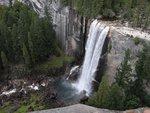Hantavirus Pulmonary Syndrome
The National Park Service was notified in early August 2012 by the California Department of Public Health (CDPH) of two probably cases of Hantavirus Pulmonary Syndrome (HPS) that may have occurred as a result of possible exposure while staying in the historic Curry Village tent cabins in Yosemite National Park.
What is Hantavirus Pulmonary Syndrome?
Hantavirus Pulmonary Syndrome (HPS) is a rare, but often fatal, disease of the lungs. HPS was first recognized in 1993 in the southwestern United States.
How do you get HPS?
Infected rodents shed hantavirus in their urine, droppings, and saliva. Most HPS patients become infected by breathing air contaminated with rodent urine or droppings, such as when cleaning out a rodent-infested space. This most commonly occurs in small, confined spaces where there is little air circulation. Rarely, individuals can also be infected by: 1) consuming food contaminated with rodent urine or droppings; 2) touching surfaces where rodents have been, and then putting their hand in their mouth; 3) being bitten by an infected rodent.
Why does CDHP think the exposure could have occurred in Yosemite?
While it is impossible to determine where both patients contracted HPS, both HPS patients had visited Yosemite in June 2012. The first visitor stayed in the Curry Village tent cabins from June 10-12 and showed an onset of illness on June 26. The second visitor stayed in the tent cabins between June 10-13 and became ill on July 23. The Centers for Disease Control identify the incubation period of HPS as one to six weeks. The cabins where the guests stayed are within 100 feet of each other.
In addition to the timing of the guests’ visits and illness the California Department of Public Health (CDPH), Vector-Borne Disease Section (VBDS), performed a rodent and hantavirus risk assessment at and around Curry Village on August 9, 2012 with the NPS. Hard sided and soft sided (canvas) cabins were assessed both inside and outside. With NPS and USPHS concurrence, they concluded that the public should be notified that a probable source of HPS might have been at Yosemite.
What is the park doing to prevent HPS in Yosemite?
The cabins where the exposure may have occurred have since been thoroughly cleaned and disinfected, which is a regular practice of good housekeeping for the park’s concessioner Delaware North Corporation (DNC). DNC routinely cleans, maintains, and monitors all lodging in the parks for hantavirus prevention.
The National Park Service works with the US Public Health Service and CDPH to assess the risk of HPS to humans and provide public education and outreach about the disease. The park updated its Hantavirus Risk Reduction Program in April 2012. The park has an on duty U.S. Public Health Officer who leads trainings, investigations and site assessments. The U.S. Public Health Officer also conducts routine rodent proofing and pest management inspections and assessments of buildings and facilities throughout Yosemite National Park.
Can I still come to Yosemite?
Yes, HPS is a rare illness. No other cases of HPS have been reported this year in Yosemite National Park. The park annually receives around 4 million visitors with approximately 2 million visiting during the summer months.
The park is a natural environment that contains wild animals including rodents. While it is impossible to eliminate all rodents from Yosemite National Park, the park and concessioner conduct routine rodent proofing and pest management inspections and assessments of buildings and facilities throughout the park. If visitors notice rodent droppings, they should contact staff immediately. NPS and concessioner staff are trained and equipped to respond to evidence of rodent activity.
What can you do to protect yourself?
When you are in areas or places that harbor mice, you can take the following steps to prevent HPS:
- Avoid areas, especially indoors, where wild rodents are likely to have been present.
- Keep food in tightly sealed containers and store away from rodents.
- Keep rodents out of buildings by removing stacked wood, rubbish piles, and discarded junk from
around homes and sealing any holes where rodents could enter. - If you can clean your sleeping or living area, open windows to air out the areas for at least two hours
before entering. Take care not to stir up dust. Wear plastic gloves and spray areas contaminated with
rodent droppings and urine with a 10% bleach solution or other household disinfectants and wait at
least 15 minutes before cleaning the area. Place the waste in double plastic bags, each tightly sealed,
and discard in the trash. Wash hands thoroughly afterward. - Do not touch or handle live rodents and wear gloves when handling dead rodents. Spray dead rodents
with a disinfectant and dispose of in the same way as droppings. Wash hands thoroughly after
handling dead rodents. - If there are large numbers of rodents in a home or other buildings, contact a pest control service to
remove them.


